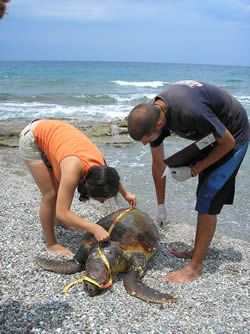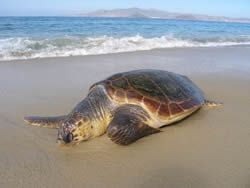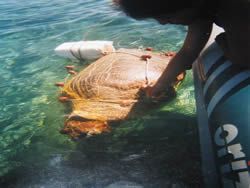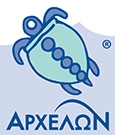TURTLE STRANDINGS HIT A RECORD IN 2008!
by Dimitris Margaritoulis and Pavlos Tsaros

Today the Network operates in full development, but there is always room for improvements. Members of the Network are all Coast Guard Stations which constitute its backbone and also municipalities, environmental organizations, groups of citizens, and many concerned individuals. Main objective of the Network is the reliable collection of information concerning deaths and injuries of sea turtles, aiming at mitigating the causing factors.
How the Network operates Observed strandings are reported by the network members with the filling of a special data sheet where the gender, size, and sex of the turtle are noted as well as other information (injuries, if the turtle is tagged, etc.). Network members inform always the local Coast Guard Station which calls the state vet to examine the cause of death and the local municipality to bury the dead animal. Data sheets are transmitted to the Rescue Centre where they are entered in a database and further analysed with GIS. Obviously in case of an injured turtle the communication with the Rescue Centre is immediate in order to arrange for the animalʼs transport to the Centre. Information of what you should do in case you encounter an injured or dead turtle you can find in http://www.archelon.gr/eng/nationalnetwork.php?row=row9

The results The annual number of strandings (only the dead turtles) for the period 1994-2008 is shown on the graph below.

In the period 1994-2001 there is an upward trend with a maximum in 2001. However, this increase can be attributed – at least partly - to the increase of the networkʼs members and the raising of public awareness during this period. We shouldnʼt forget that sensitized citizens are mainly the ones who, in case they encounter a stranded turtle, inform either the local Coast Guard or the Rescue Centre.
From the graph it is seen that the period 2001-2004 is characterized by a continuous decrease until 2004. Here it should be noted that in this period ARCHELON was doing great efforts to inform and sensitize fishermen throughout Greece. These efforts, materialized through a diversity of actions, were co-financed by a European project aiming to reduce turtle mortalities at sea (LIFE/NAT/GR8500). This project has recently been declared as one of the most successful in European level.
Further, from 2004 until 2008 there is a continuous increase in the annual number of strandings with a peak of 292 strandings during 2008 (increase from 2004: 126%!).
What should be done It is clear that many turtles are captured incidentally in fishing gear. Internationally there are efforts to reduce these entanglements. Some countries have enforced the Turtle Excluder Device (TED), a device which automatically releases turtles captured in trawl nets. There is also ongoing research for the introduction of a new type of hook, the circle hook, which does not catch as many turtles as the conventional ones, in surface long-lines targeting tunas and swordfish. It is very difficult to do anything technical to reduce turtle by-catch in small-scale fisheries using static nets, bottom long-lines and beach seines. These widespread fishing gear will continue to catch turtles and some of them will inevitably die because they would not be able to breathe. Nevertheless the ones who survive the capture should be immediately released unharmed by the fishermen.
Sea turtles play important ecological roles in the marine ecosystem; in their diet they include jellyfish and crabs, both of which if their populations grow uncontrolled, may cause problems not only to the ecosystem but also to the fishermen. Many fishers have understood that a healthy sea cannot contain only first-class fish! All marine organisms play their role in a complex food web, through which the fish are also developed. For instance, in Amvrakikos Bay the many crabs create problems to local fishermen and the turtles in the Bay, feeding on crabs, contribute to the preservation of the ecological balance.

29th Annual Symposium on Sea Turtle Biology and Conservation
Again this year ARCHELON is present at Thessalonikiʼs Documentary Festival
RECENT NEWS
- OUR NEWS08/12/2025
Applications Now Open for 2026 ARCHELON Field Leaders Posts!
ARCHELON is pleased to announce that applications are now open for the 2026 Field Leader positions across all nesting projects (applications open until January 31st).
- OUR NEWS05/12/2025
Saving Sea Turtles Together – A Tribute to Volunteers
On Volunteer Day, we take a moment to celebrate all those who came from near and far, put on the blue T-shirt, and embraced this important responsibility.
- OUR NEWS01/12/2025
Laganas Bay, Zakynthos: Successful Loggerhead Reproduction, Ongoing Habitat Problems
On the beaches of the Zakynthos National Marine Park, around 2,155 turtle nests successfully hatched thanks to active protection measures, but human pressures on coastal and marine habitats continue.
- OUR NEWS26/11/2025
A Second Chance: Two Loggerhead Sea Turtles Return to the Sea Thanks to Dedicated Rescues
This summer, two adult loggerhead sea turtles, ‘Aktaia’ and ‘Herbert’, arrived at ARCHELON’s Sea Turtle Rescue Centre needing urgent help after sustaining severe head injuries.
- OUR NEWS11/11/2025
Volunteering Projects 2026: Sea Turtles Need You, the Planet Needs Us!
ARCHELON welcomes volunteers from all over the world and of all ages (over 18) and no prior experience is required! If you speak English, are at least 18 years old, and are in good physical condition, you can do this!
- OUR NEWS10/11/2025
Outstanding Recognition for ARCHELON at the Effective Dialogue Conference 2025
On Thursday, November 6, 2025, ARCHELON received an honorary distinction for its substantial contribution to effective dialogue on sustainability, social responsibility, and the environment
- OUR NEWS06/11/2025
6th Year of Online Tours: The sea turtles are traveling across Greece once again!
Students from every corner of the country, as well as from international schools, have the opportunity to learn up close about the lives of the turtles cared for at the Sea Turtle Rescue Centre in Glyfada, Attica, and to discover how rescue efforts impact the marine world.
- OUR NEWS31/10/2025
The lecture turned into reality: A real turtle rescue for the students from Kallithea!
The students spotted a sea turtle floating in the water right after their educational tour of the ARCHELON Rescue Centre and immediately notified the rescuers.
- OUR NEWS24/10/2025
LIFE MareNatura Documentary Premier
From seabird monitoring and genetic sampling, to unique underwater footage of marine mammals, the testimonies of scientists bring to life the hidden stories of the sea.
- OUR NEWS23/10/2025
ARCHELON participates in the "Science Festival 2025 – The Voice of the Ocean"
The French Institute of Greece is organizing a celebration from 10 to 27 November 2025 dedicated to science and the ocean! World premiere of the LIFE MareNatura documentary on November 13th.
- OUR NEWS22/10/2025
Kyparissia Bay: ARCHELON Records 6,100 Nests and Calls on the State to Immediately Implement the National Action Plan for the Loggerhead
In 2025 approximately 6,100 nests were recorded, marking a 74% increase compared to the average of the previous 12 years!
- OUR NEWS10/10/2025
We bid farewell to a devoted environmentalist and friend, Yiannis Roussopoulos.
- OUR NEWS02/10/2025
Jane Goodall’s words still warm our hearts
Thank you, Dr. Goodall, for all that you have taught us and for the life example you have left behind.
- OUR NEWS29/09/2025
Turtles, Dolphins, and Birds: Local Communities and Scientists come together for the future of Amvrakikos Gulf
A one-day conference held on Wednesday, September 24, in Menidi, Amfilochia, united the voice of the local community with leading scientists and environmental organizations for Amvrakikos Gulf.
- OUR NEWS26/09/2025
Biologists from the 'LIFE ADAPTS' project send their message to the community


